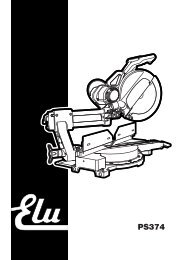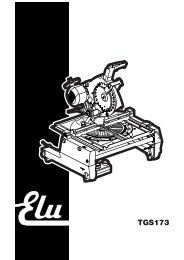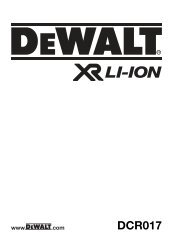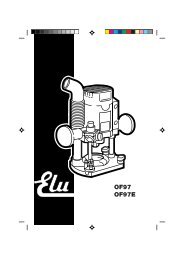XXXX man hammer D25103 Euro.indd - Service après vente - Dewalt
XXXX man hammer D25103 Euro.indd - Service après vente - Dewalt
XXXX man hammer D25103 Euro.indd - Service après vente - Dewalt
Create successful ePaper yourself
Turn your PDF publications into a flip-book with our unique Google optimized e-Paper software.
ENGLISH<br />
• Be aware of the location of pipework<br />
and wiring.<br />
• Apply only a gentle pressure to<br />
the tool (approx. 5 kg). Excessive<br />
force does not speed up drilling but<br />
decreases tool perfor<strong>man</strong>ce and may<br />
shorten tool life.<br />
• Do not drill or drive too deep to<br />
prevent damage to the dust cover.<br />
• Always hold the tool firmly with both<br />
hands and ensure a secure stance<br />
(fig. 7). Always operate the tool with<br />
the side handle properly mounted.<br />
Proper Hand Position (fig. 1, 7)<br />
WARNING: To reduce the risk of<br />
serious personal injury, ALWAYS use<br />
proper hand position as shown.<br />
WARNING: To reduce the risk of<br />
serious personal injury, ALWAYS hold<br />
securely in anticipation of a sudden<br />
reaction.<br />
Proper hand position requires one hand on the side<br />
handle (i), with the other hand on the main handle<br />
(k).<br />
Switching On and Off (fig. 1)<br />
1. To run the tool, press the variable speed switch<br />
(a). The pressure exerted on the variable speed<br />
switch determines the tool speed.<br />
2. For continuous operation, press and hold down<br />
the variable speed switch, press the lock-on<br />
button (b) and release the switch.<br />
3. To stop the tool, release the switch.<br />
4. To stop the tool in continuous operation, press<br />
the switch briefly and release it. Always switch<br />
off the tool when work is finished and before<br />
unplugging.<br />
Hammerdrilling (fig. 1)<br />
DRILLING WITH A SOLID BIT<br />
1. Set the mode selector switch (d) to the<br />
<strong>hammer</strong>drilling position.<br />
2. Insert the appropriate drill bit.<br />
NOTE: For best results use high quality carbidetipped<br />
bits.<br />
3. Adjust the side handle (i) as required.<br />
4. If necessary, set the drilling depth.<br />
5. Mark the spot where the hole is to be drilled.<br />
6. Place the drill bit on the spot and switch on the<br />
tool.<br />
7. Always switch off the tool when work is finished<br />
and before unplugging.<br />
DRILLING WITH A CORE BIT<br />
1. Set the mode selector (d) to the <strong>hammer</strong>drilling<br />
position.<br />
2. Adjust the side handle (i) as required.<br />
3. Insert the appropriate core bit.<br />
4. Assemble the centerdrill into the core bit.<br />
5. Place the centerdrill on the spot and press the<br />
variable speed switch (a). Drill until the core<br />
penetrates into the concrete approx. 1 cm.<br />
6. Stop drilling and remove the centerdrill. Place<br />
the core bit back into the hole and continue<br />
drilling.<br />
7. When drilling through a structure thicker than<br />
the depth of the core bit, break away the round<br />
cylinder of concrete or core inside the bit at<br />
regular intervals. To avoid unwanted breaking<br />
away of concrete around the hole, first drill a<br />
hole the diameter of the center drill completely<br />
through the structure. Then drill the cored hole<br />
halfway from each side.<br />
8. Always switch off the tool when work is finished<br />
and before unplugging.<br />
Rotary Drilling (fig. 1)<br />
1. Set the mode selector switch (d) to the “rotary<br />
drilling” position.<br />
2. Fit the chuck adapter/chuck assembly.<br />
3. Proceed as described for <strong>hammer</strong>drilling.<br />
WARNING: Never use standard chucks<br />
in the <strong>hammer</strong>drilling mode.<br />
Screwdriving (fig. 1)<br />
1. Set the mode selector switch (d) to the rotary<br />
drilling position.<br />
2. Select the direction of rotation.<br />
3. Insert the special SDS Plus ® screwdriving<br />
adaptor for use with hexagonal screwdriver bits.<br />
4. Insert the appropriate screwdriver bit. When<br />
driving slotted head screws always use bits with<br />
a finder sleeve.<br />
5. Gently press the variable speed switch (a) to<br />
prevent damage to the screw head. In reverse<br />
(LH) rotation the tool speed is automatically<br />
reduced for easy screw removal.<br />
31
















